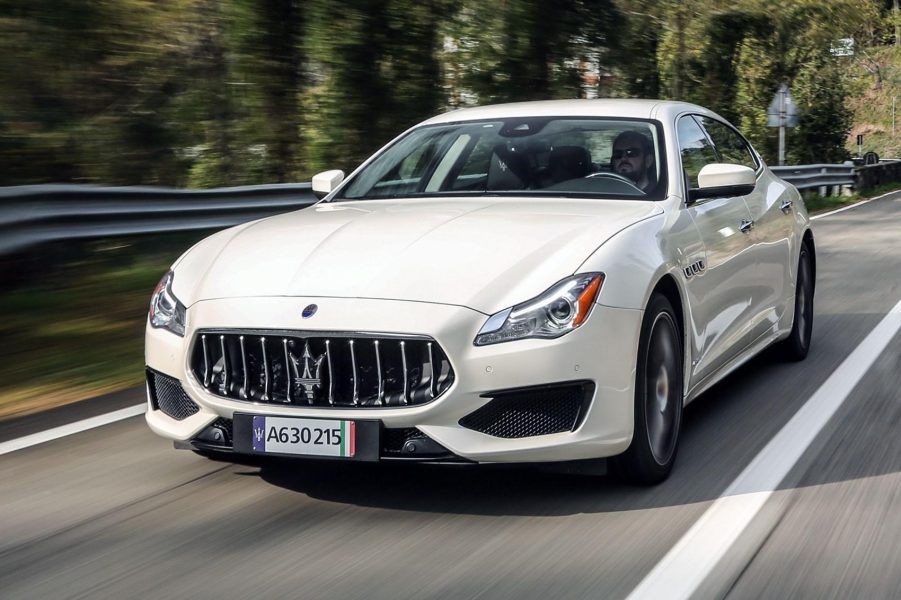
Maserati Quattroporte 2016 review
Content
John Carey conducts road tests and reviews of the Maserati Quattroporte, including performance, fuel consumption and the verdict at its international launch in Europe.
Back in 2013, the launch of the new Quattroporte marked the beginning of a new era for Maserati. The engines and chassis, first seen on the drawing board, first seen in the company's big flagship, were then used as the basis for the smaller Ghibli sedan and then the Levante, Maserati's first SUV unveiled earlier this year.
The cute Ghibli gave a huge boost to Maserati sales and was the main model responsible for the Italian brand's rapid growth in worldwide sales from 6000 to over 30,000 a year. The Levante, due in Australia later this year, is sure to be even more successful than the Ghibli.
But Maserati doesn't want the Quattroporte to be overshadowed by the better-selling models it has produced, let alone be overlooked by customers.
So, a little over three years after the appearance of the sixth generation Quattroporte, an updated version is ready.
What Maserati hasn't changed much is the driving style of the Quattroporte. The engine range has remained the same, and the big Italian remains more energetic and agile than its looks and length would suggest.
Technical changes are small. The power of the less powerful version of the 14-litre V3.0 twin-turbo engine has been increased by 6 kW.
The powerful option for the Quattroporte S, the 3.0-liter V6 turbodiesel and the manic 3.8-liter twin-turbo V8 for the GTS remain unchanged. What remains is the eight-speed automatic transmission along with the annoying, clunky and confusing shifter.
There is probably no other turbodiesel in the world that sounds as good as the V6 in the big Maserati.
At over 5m long and weighing just under 2 tons, the Maserati has the same visual and physical weight as the long-wheelbase versions of the latest BMW 7 Series and Mercedes-Benz S-Class.
In the same way that Saxony is not like Sicily, although both are part of Europe, Quattroporte differs from the German heavyweights in individuality. As if to highlight the contrast, Maserati has unveiled its updated limousine on the roads around Palermo, the capital of Sicily.
Carsguide tried the Diesel and S models. The former is powered by a 202kW 3.0-litre V6 turbodiesel, while the latter is powered by Ferrari's version of the 302-litre 3.0kW V6 twin-turbocharged engine built for Maserati.
The character of the Quattroporte owes much to its engines. There is probably no other turbodiesel engine in the world that sounds as good as the V6 in the big Maserati, but it has more bark than bite. Sleek and muscular, it lacks the quick response that the trident badge promises and feels tame compared to the S's petrol V6.
Made in Maranello, the V6 twin-turbo is a hyperactive mesh leash. Let him go and he'll fly away with puppy-like enthusiasm. With the sport driving mode selected (to keep the noise dampers open in the mufflers), there is also a surprising amount of noise. Breed quality, of course.
Regardless of what's under the hood, sport mode makes a big difference in handling.
The extra power from the S engine is enough to really test the Maserati's tires and suspension, but you can count on the Quattroporte's chassis control electronics to keep things just right.
Regardless of what's under the hood, sport mode makes a big difference in handling. Standard adjustable dampers switch to stiffer ones, and the steering becomes more weighty, boosting cornering agility and driver engagement to levels rarely seen in a limousine.
Maserati's normal mode aims for the same calm as its rivals. On uneven roads, the softness of the shock absorbers in normal mode sometimes resembles a rocking boat. Like the original 2009 Quattroporte, it replaces it.
Technical changes for the updated car are small. Measurements that reduce aerodynamic drag by 10 percent result in slightly higher top speeds.
Maserati's big step is the introduction of two new model classes called GranLusso and GranSport.
The appearance of the Quattroporte is not much different. The updated grille with chrome vertical stripes is the easiest way to identify an upgrade.
Maserati's big move is the introduction of two new model classes called GranLusso and GranSport, aimed at giving customers two different paths to a more luxurious Quattroporte.
These are surcharge options for buyers in Europe and other markets, but will be standard on most models in Australia.
The Quattroporte is due in December, but Australian importer Maserati hasn't finalized pricing yet. The richer content of the GranLusso and GranSport packages is likely to translate into higher prices for V6 petrol models and top-of-the-line V8 models that come standard with them.
The cheapest model, the Diesel, will only be sold in base form in Australia and will cost around $210,000 compared to the current car.
"Lusso" means luxury in Italian and that's what GranLusso strives for. The focus here is on interior luxury.
There is no reward for guessing what GranSport is about. This package includes large 21-inch wheels and specially designed sports seats. The large GranSport wheels and their low-profile tires make the Quattroporte a nimble car to drive in sport mode, but it has great traction and is more agile than its German rivals.
Otherwise, the updated Quattroporte is catching up with the Germans. A new suite of driver aids, including autonomous emergency braking and very good adaptive cruise control, makes the Italian almost a competitor rather than a driver. Maserati has upgraded the multimedia with a larger touchscreen and a new controller on the center console.
This update undoubtedly creates an improved Quattroporte, but the Italian flair remains as strong as ever. This is probably what the growing group of Maserati buyers prefer.
Which Quattroporte would you prefer, GranLusso or GranSport? Tell us what you think in the comments below.
Click here for more pricing and specifications for the 2016 Maserati Quattroporte.
